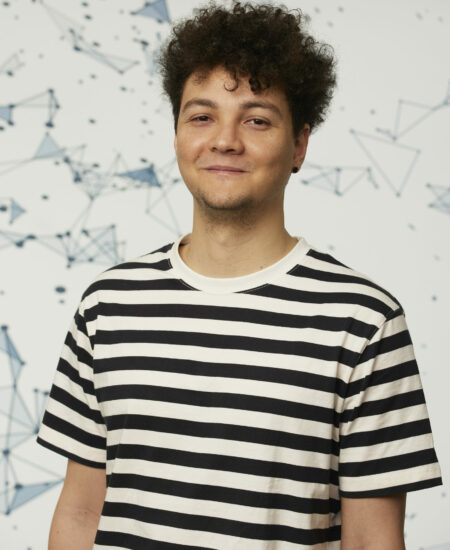IMDEA Networks


Dr. Orlando E. MARTÍNEZ-DURIVE
Post-Doc Researcher
- Graduation date: Jul 2025
- Affiliation: IMDEA Networks Institute
- BSc: Computer Science - University of Havana. Havana, Cuba
- MSc: Computer Science - University of Havana. Havana, Cuba
- PhD: Telematics Engineering - University Carlos III of Madrid. Madrid, Spain
- BSc. Thesis: Low auto correlation binary sequences explored using message passing algorithms
- MSc. Thesis: A system to analyze human mobility in Cuba using mobile phone data
- Ph.D. Thesis: Understanding Societal Phenomena and Network Operations with Mobile Metadata
- Ph.D. Supervisor: Dr. Marco FIORE
- Former position: Research Assistant, Physics Faculty, University of Havana, Cuba
- Joining date: November 2020
- Email: orlando.martinezimdea.org
Biography
I am a Postdoctoral Fellow in the Networks Data Science Group at IMDEA Networks Institute, and a Machine learning researcher at NetAI, a mobile network intelligence startup.
During my PhD (Cum Laude) in Telematics Engineering at Carlos III University of Madrid, I studied how we can understand Societal Phenomena and optimize network operations through the lens of Mobile Network Metadata. Also, I had the opportunity to plan, implement, and communicate computational research projects based on large-scale datasets. While closely collaborating with several academic researchers from different countries and major European industry players, such as Telefónica and Orange.
A big part of my PhD was carried out as an intern and visiting roles, including:
Research Internship at Cisco ThousandEyes in Crete, Greece, under the supervision of Antonis Chariton and Sergio Freitas. We analyzed the impact of exceeding the Maximum prefix limit in BGP and its relationship to peer connectivity.
Visiting PhD student in the Social and Urban Networks Lab at the Network Science Institute, Northeastern University in Boston, USA, under the supervision of Prof. Esteban Moro. We analyze how mobile apps can be used to understand election outcomes and political polarization.
Visiting researcher at Telefónica Innovación Digital, Spain, supervised by Dr. Andra Lutu. Between February 2023 and August 2024 (1.5 years), we studied and measured the impact of energy-saving policies in the Radio Access Network (RAN) by analyzing large-scale datasets of KPIs and RAN deployment.
My research lines focus on network measurements, remote sensing, and ML/AI solutions. With a specific interest in:
- ML solutions for energy-saving policies for mobile networks.
- Using mobile networks as sensors for social events
- Infering political orientation through mobile app consumption.
- How do people use the space in cities?
- Infering the base station coverage area with minimal data.
- Impact of misconfiguration in BGP.
However, I have always been passionate about everything related to Human mobility, Social disparity and inequality, and combinatorial optimization.
I like being part of the community, which motivates me to contribute to the Technical Program Committee (TPC) for PAM 2026 & 2025, the TPC shadow for ACM IMC 2025 & 2022, and the TPC for the 1st IEEE Workshop on Quality of Data in Network Telemetry.
Also, as external reviewers for conferences and journals like:
- IEEE Networking Letters
- Sustainable Cities and Society Complex Networks 2021
- IFIP Networking 2021 & 2022
- International Symposium on Personal, Indoor, and Mobile Radio Communications. (PIMRC) 2022
- Network Traffic Measurement and Analysis Conference (TMA) 2022
- Journal of Maps (2022)
In addition, I helped organize conferences such as PAM 2023 and Netmob 2023, and I participated in the Madrid Science Fairs of 2023, 2024, and 2025.
I supported Professor Marco Gramaglia as a Teaching Assistant at UC3M in the Access Networks and Shared Media course for undergraduate students of Telematics Engineering & Sound and Image Engineering.
Some of my work has appeared in IEEE INFOCOM (x3), IEEE SECON (x2), ACM IMC, and IEEE/IFIP TMA. For updated bibliometrics, you can check my Google Scholar profile.
Research projects
NetSense+1
Talent Attraction grant - One-year Extension
More infoarrow_right_alt
Publications
Modeling Base Station Metadata Geolocation (Poster)
Orlando E. Martínez-Durive, Stefanos Bakirtzis, Cezary Ziemlicki, Marco Fiore
Netmob 25. Paris, France. October 2025
Understanding Societal Phenomena and Network Operations with Mobile Metadata (PhD)
Orlando E. Martínez-Durive
pp. 212 , July 2025
Demonstrating Deep Learning-based Spatial Diffusion (Demo)
Orlando E. Martínez-Durive, Stefanos Sotirios Bakirtzis, Cezary Ziemlicki, Marco Fiore
IEEE Conference on Computer Communications Workshops. London, United Kingdom. May 2025
An Evaluation of RAN Sustainability Strategies in Production Networks
Orlando E. Martínez-Durive, José Suárez-Varela, Jesús Omaña Iglesias, Andra Lutu, Marco Fiore
IEEE International Conference on Computer Communications. London, United Kingdom. December 2024
Characterizing, Modeling and Exploiting the Mobile Demand Footprint of Large Public Protests
André Felipe Zanella, Diego Madariaga, Sachit Mishra, Orlando E. Martínez-Durive, Zbigniew Smoreda, Marco Fiore
Internet Measurement Conference. Madrid, Spain. November 2024
Previous publications
-
Intra-day Population Fluxes from Mobile Phone Data in Havana, Cubacall_made
.
For the first time in Cuba, we use Location Update records from the mobile phone network to generate origin-destination matrices in Havana. We used 15-days telecom anonymized data from 2020 to approximate trips identified as sequences of cellphone towers. We projected these trips over transport areas and municipalities, and showed the plausibility of the fluxes by comparing it with known behaviour of the city and data from census and work-home survey.
-
Low Auto-Correlation Binary Sequences Explored using Warning Propagationcall_made
.
The search for binary sequences with low auto-correlations (LABS) is a computationally hard discrete combinatorial optimization problem. We explore two physically inspired algorithms to explore the low energy space of this model. The greedy, T = 0, Monte Carlo (MC) method gets trapped in the exponentially many 1-Spin-Flip stable configurations, that are typically low in energy, but still far from the global optimum. The more elaborated Warning Propagation (WP) algorithm also gets trapped in local minima. However, these local minima, are more stable to spin flips than the ones obtained by the greedy MC. We also compare the behavior of both algorithms in randomized versions of LABS, showing that the low energy space of the 4-Spin model is easier to explore than the one of LABS.
-
La Habana: Atlas de la COVID-19call_made
.
Los geógrafos han concertado esfuerzos con epidemiólogos, matemáticos, especialistas en ciencias de la computación, físicos, demógrafos… para conformar una obra cartográfica inusual, marcada justamente por la mirada multi- y transdisciplinar, con un enfoque espacio-temporal de la epidemia en La Habana, epicentro casi sostenido de la enfermedad en Cuba. La elevada conectividad entre todos los territorios que integran la provincia se convierte en factor de potencial trasmisión del virus; de ahí la mirada diferenciada a la que hay que recurrir y que de alguna manera se presenta en este texto.
-
Ciencia e innovación: desafíos a la multidisciplinariedad ante la COVID-19call_made
.
Primera mirada al aporte de ciencia e innovación de la Universidad de La Habana al enfrentamiento a la COVID-19 desde una perspectiva multidisciplinar. […] El volumen que presentamos no implica el cierre de un proceso, sino el balance del trabajo realizado en un período inicial, en medio de la fragua continua de estos tiempos. Lo anima la propia vocación de servicio de sus autores: poner al acceso público, sin dilaciones, la obra investigativa e innovadora que se ha ido gestando para que fructifique, para que se convierta en conocimiento compartido, apropiación de un saber y una experiencia a emplear, incluso, más allá de las fronteras nacionales. Plasmar la germinación pronta, desatendiendo la ponderación sabia que permite la distancia crítica, es imperativo en estos momentos. Aquí quedan las huellas de la incertidumbre con que grava la epidemia; de la incompletitud en el desentrañamiento de la operatoria del SARS-CoV-2 y de la enfermedad que produce; del empleo de información estadística que no ha pasado por los «reparos» de rigor en las bases de datos… pero está la fuerza de una ciencia y una innovación de altísima profesionalidad, que también deja referentes en lo concerniente a experiencia, metodologías y sistemas de conocimientos, de validez presente y futura. Queda, asimismo, la construcción de una memoria, de tanta importancia para la propia ciencia, para la Universidad y la educación superior en general, y para la nación.
News
- Talking about BGP issues 🚫 in RIPE 91 🇷🇴
- Best poster award 🥇 in NetMob 2025 🇫🇷!!
- Joining NetAI as ML Researcher 🤖!
- I completed my PhD 🎓🎓 (Cum lauden and International mentions 🥳)!
- 🎉 An Evaluation of RAN Sustainability Strategies... was presented at Infocom in London 🇬🇧
- I'm joining as a research intern at Cisco ThousandEyes 🤓
- Hands-on AI and Mobile Systems in Como, Italy 🇮🇹
- See you soon Boston 🥹! I finished my internship at The Network Science Institute 🇺🇸.
- 🎉 Yeeiii, "An Evaluation of RAN Sustainability Strategies in Production Networks" was accepted at INFOCOM 2025.
- 🎉 SIGSPATIAL in Atlanta - Uncovering Latent Patterns in Service-Level Spatiotemporal Mobile Traffic 🇺🇸
- 🎉 DeepMend accepted at SECON 2024 🇺🇸
- 🎉 Characterizing, modeling and exploiting the mobile demand footprint of large public protests accepted at IMC 2024 🇪🇸
- NetMob 2024 at the World Bank 🏦 🇺🇸
- I finished my internship at Telefónica Innovación Digital 📱🇪🇸
- Workshop at the Centre Tecnològic de Telecomunicacions de Catalunya 📚 🇪🇸
- 🎉 Characterizing 5G Adoption... was accepted at INFCOM 2024 🇨🇦
- NetMob 2023 at the UC3M in Madrid 🇪🇸
- 🎉 France Through the Lens of Mobile Traffic Data at TMA in Naples, Italy 🇮🇹
- Announcing the NetMob 2023 Data Challenge 💻
- 🎉 Impact of Later-Stages COVID-19 ... was accepted at INFCOM 2022 🌎
- 🎉 VoronoiBoost accepted at SECON 2022 🎉 🌎

